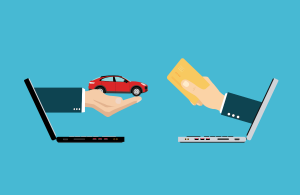How to Build Credit for a Car Purchase

How Cosigning Impacts Your Credit Score
07/27/2022
Credit Building for Military Members
08/04/2022 A car is a major purchase. With the price of both new and used cars rising fast, it’s not a surprise that most of us have to take out a loan to finance this big expense.
A car is a major purchase. With the price of both new and used cars rising fast, it’s not a surprise that most of us have to take out a loan to finance this big expense.
If you are planning to take out a loan for your car purchase, your credit score matters. The right credit score can set you up to save thousands on your car loan. It can take time to build up a good credit score. But the results can be well worth the effort.
Today we will explore how to build credit for your car purchase.
Car Loans and Credit
Whether you are shopping for a new or used car, financing the cost can lead to high monthly payments.
In the first quarter of 2022, Experian found that the average car payment was $648 per month for a new car. Even a used car payment is a big hit to the budget at $503 per month.
The reality is that a high monthly car payment is a drain on your finances. That’s especially true if you are stuck with a high interest rate. Since the average loan term is sitting just under 70 months, the cost of financing a car can really add up.
Lock in Lower Monthly Payments
So, how does your credit score come into the picture? In general, a better credit score leads to a lower interest rate, which in turn means a lower monthly car payment.
The Experian State of Automotive Finance Market report showed how a better credit score could lead to big savings.
For new cars financed in the first quarter of 2022, consumers with a credit score between 781 and 850 had an average monthly payment of $548. That’s compared to a $604 average monthly payment for drivers with a credit score between 601 and 660.
The same trend held true for used vehicles. Shoppers with a credit score between 781 and 850 had an average monthly payment of $405. But shoppers with a credit score between 501 and 600 paid an average of $427 per month.
Save on Interest Payments
A lower monthly payment is attractive. But that’s not the only way credit scores come into play. A higher credit score can also unlock better interest rates. Depending on your situation, the lower interest rate could lead to thousands saved over the life of the loan.
Let’s consider two examples to see how interest savings are possible.
Buyer 1 has a high credit score of 785 which allows them to tap into a 3% interest rate. They take out a loan for a new car with an average amount of $39,540. With a loan term of 72 months, their monthly payment is $601. Over the life of the loan, they’ll pay $3,715 in interest.
Buyer 2 has a lower credit score of 650 which allows them to get a credit score of 6%. Like Buyer 1, they take out a 72-month loan for $39,540. But their monthly payment is $637. At the end of the day, Buyer 2 pays $6,309 in interest.
Thanks to a higher credit score, Buyer 1 was able to save $2,594 in interest payments over the life of the loan. It’s a major saving that illustrates the importance of building a good credit score before moving forward with a car purchase.
How to Shop for a Car in 2022
If you are shopping for a car in 2022, inventory constraints make for a challenging experience. But it’s still possible to drive off the lot with a vehicle that suits your needs.
Here are a few tips to consider before jumping into the car buying process.
- Search high and low. A car is a major purchase. So, you shouldn’t settle for a vehicle just because it is available. Although compromising on color and extra perks is one thing, you can’t commit to a car that won’t function for you and your family. If you can’t find what you are looking for in town, then consider expanding your search to out-of-town dealers.
- Order from the factory. If you are buying a new car, then you can order it straight from the automaker. You’ll need to know exactly what you want before you order.
- Call around to find a deal: Searching online for a vehicle will only get you so far. It’s worth calling around to dealers to lock in a deal.
- Get a used vehicle inspected: Before committing to a used vehicle, an engine inspection is in order. An independent mechanic can let you know if there are any glaring mechanical issues with the ride.
- Start with a budget: Sticking to a budget is easier said than done in today’s car market. But with the average auto loan sitting around $40,000, it’s critical to determine a number that works for your budget. Don’t be afraid to opt for an older model to cut down on costs.
Want more tips to wade through the car shopping process? Check out this full guide to car shopping in 2022.
How to Build Credit for Car Purchase
A good credit score can set you up for a more affordable car ownership experience. Of course, you can still obtain a vehicle with a bad credit score. But you might face a limited loan cap or higher interest rates that take a bigger bite out of your budget.
If you want to build credit from the ground up, here are some strategies to help you move the needle. As you work to build or rebuild credit, focus on one strategy at a time. Otherwise, the process can feel a bit overwhelming.
Make On-time Payments a Priority
Payment history accounts for 25% of your FICO score. That makes it the most important factor in your score. With that, making on-time payments to credit accounts should be a top priority. A history of on-time payments should lead to a higher credit score.
Of course, keeping up with your payments isn’t always easy.
One trick to making on-time payments is setting up autopay. If the problem is simply forgetting the deadline, autopay will take care of that. Most bill providers offer this helpful technology to help you avoid an accidentally missed payment.
But sometimes, the issue stems from a deeper cash flow issue. Generally, a cash flow issue means you know you’ll miss the payment. If possible, reach out to the creditor to explain the situation. In some cases, lenders offer a temporary forbearance or change of due date for customers that usually pay their bills on time.
Lower Your Credit Utilization Ratio
The credit utilization ratio is a measure of usage on your credit card accounts. It is one of the factors included in the debt category of your credit score, which makes up about 30% of your score.
For example, let’s say that you have a credit card with a $5,000 credit limit. If you have a balance of $1,000, then your credit utilization ratio would be 20%. Importantly, credit utilization ratios are only calculated for your credit card accounts.
A lower credit utilization ratio can give your credit score a boost. It’s best for your credit score to keep your credit utilization ratio below 10%. A utilization ratio higher than that has the potential to drag your score down.
How can you lower your credit utilization ratio? You can either increase your credit limits or pay off debt. One easy option is to call up your credit card issuer and ask for a credit increase. Depending on your financial situation, they might be happy to give your credit limit a boost.
Pay Off Debt
If you have a high debt load, that factor can negatively impact your credit score. That’s especially true if you have multiple credit card balances.
The reality is that paying off debt isn’t always easy. If you have high-interest credit card debt, that makes it even more challenging to pay off the balance. But it’s possible to implement manageable strategies to pay down debt on your credit-building journey.
One option is the snowball debt repayment strategy. In this option, you’ll pay down debts starting with your smallest balance and working your way up to the highest balance. Every time you pay off a debt, you can add that minimum monthly payment towards your ‘debt snowball’ for the next largest payment. It’s easier to tackle bigger debts as your snowball grows.
The other option is the avalanche method. Instead of working on the smallest balance first, you’ll work on the balance with the highest interest rate attached. After eliminating that debt, you’ll move on to the balance with the next highest interest rate attached until all of your debts are gone.
Although the avalanche method has a mathematical advantage, the snowball method offers small wins along the way. Choose the strategy that you think will motivate you to the end goal.
Get Credit for Your Alternative Payments
What if you don’t have any credit history at all? If you’ve been making on-time payments for certain bills that aren’t connected to a traditional credit account, you can turn that information into credit history.
A few examples of alternative payments that could add to your credit history include subscription streamlining services, utilities, rent, and cellphone plans. Since these aren’t credit accounts, you won’t build credit automatically. But if you enlist the help of a service, you can get credit for your responsible on-time payments.
Experian Boost is one free service that pulls payment information about select bills from your bank records. Rental Kharma and Rent Reports are two paid services that focus on helping consumers get credit for on-time rent payments.
The catch for any of these services is that the bills must be in your name. So, if you are splitting rent with a roommate, it needs to be your name on the lease if you want credit for that bill.
Consider a Secured Credit Card
Secured credit cards are helpful credit-building tools. When you open a secured credit card, a deposit you make will act as your credit limit.
The credit card issuer can take funds from the deposit if you aren’t paying your bills on time. So, there’s a risk of losing your deposit. But if you make on-time credit card payments, that will build a record of positive payment history.
One thing to look out for when using a secured card is your credit utilization ratio. Since you are putting up a deposit, there’s likely a low credit limit attached. So, it’s easy for your credit utilization ratio to go above the recommended 30%.
Consider a Credit-builder Loan
A credit-builder loan helps you build credit and savings.
The loan product looks like this:
You take out a credit-builder loan without receiving any funds upfront. The lender opens a savings account in your name to start stashing away the principal portion of your monthly payment. But they’ll keep the interest portion of the payment as a cost of the loan.
Each time you send in a payment, the lender reports this history to the credit bureaus. If you aren’t making on-time payments, then a credit-builder loan can have a negative impact on your credit score.
At the end of the loan term, you’ll get access to the savings you’ve created. Plus, you might see a boost in your credit score.

Try Credit Repair
Credit repair involves removing inaccurate information from your credit report. Since most mistakes will only harm your credit score, this is often an effective way to improve your credit.
You can work with a credit repair service or go the DIY route. The process starts by pulling a copy of your credit report. From there, look for any mistakes ranging from misreported payments to fraudulent credit accounts.
If you spot a mistake, file a dispute with the credit bureaus. With the right information, they will remove the mistake within 30 days. The removal of dark spots should help polish your credit score.
The Bottom Line
It will take time to build a good credit score. If possible, give yourself at least a year to work on improving your credit score before a car purchase. But that’s not always possible. At the very least, consider removing inaccurate information and building your credit.
The hard work will pay off in the form of a lower interest rate!







1 Comment
Can adding a tradeline improve your credit score for a auto loan ?